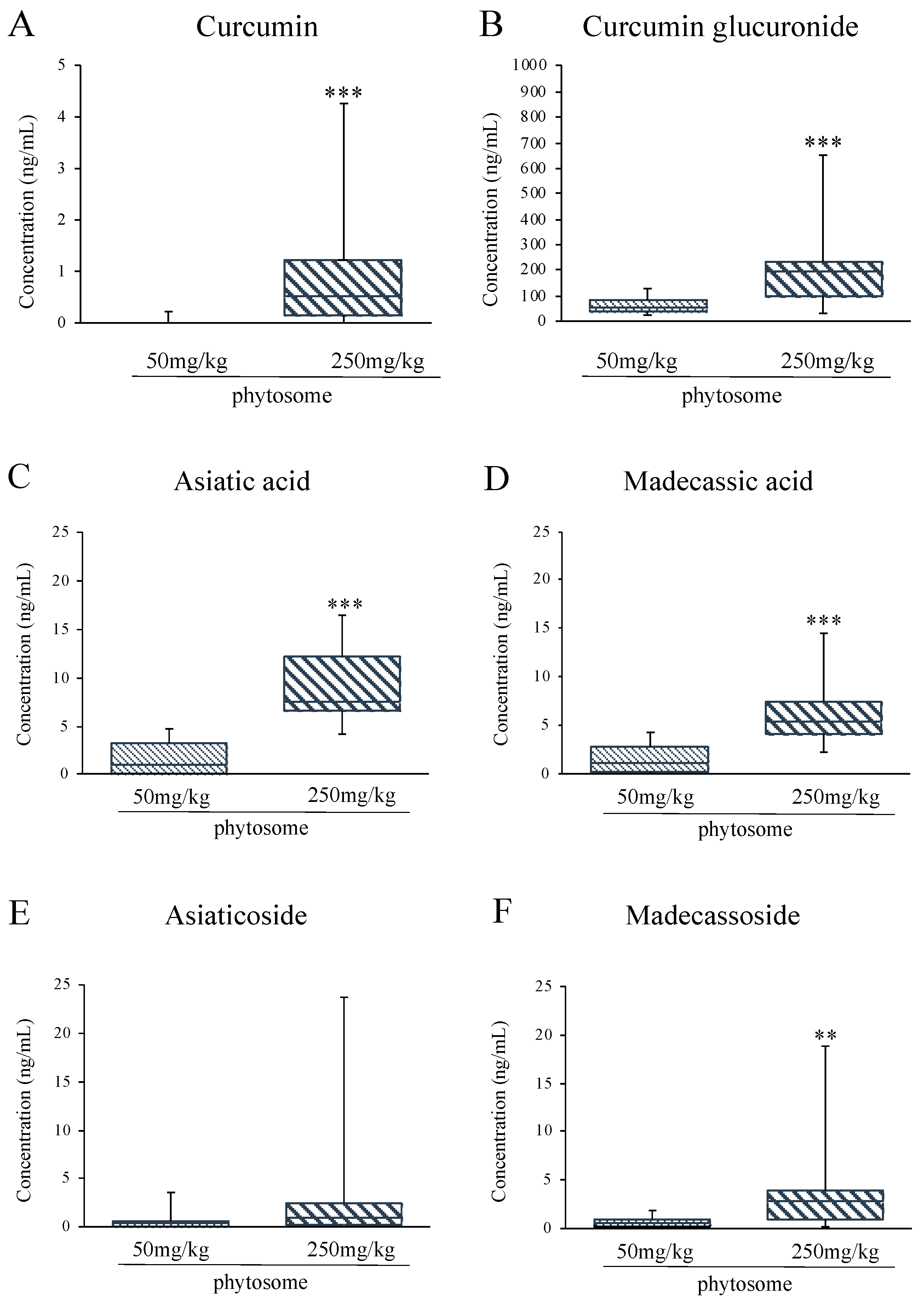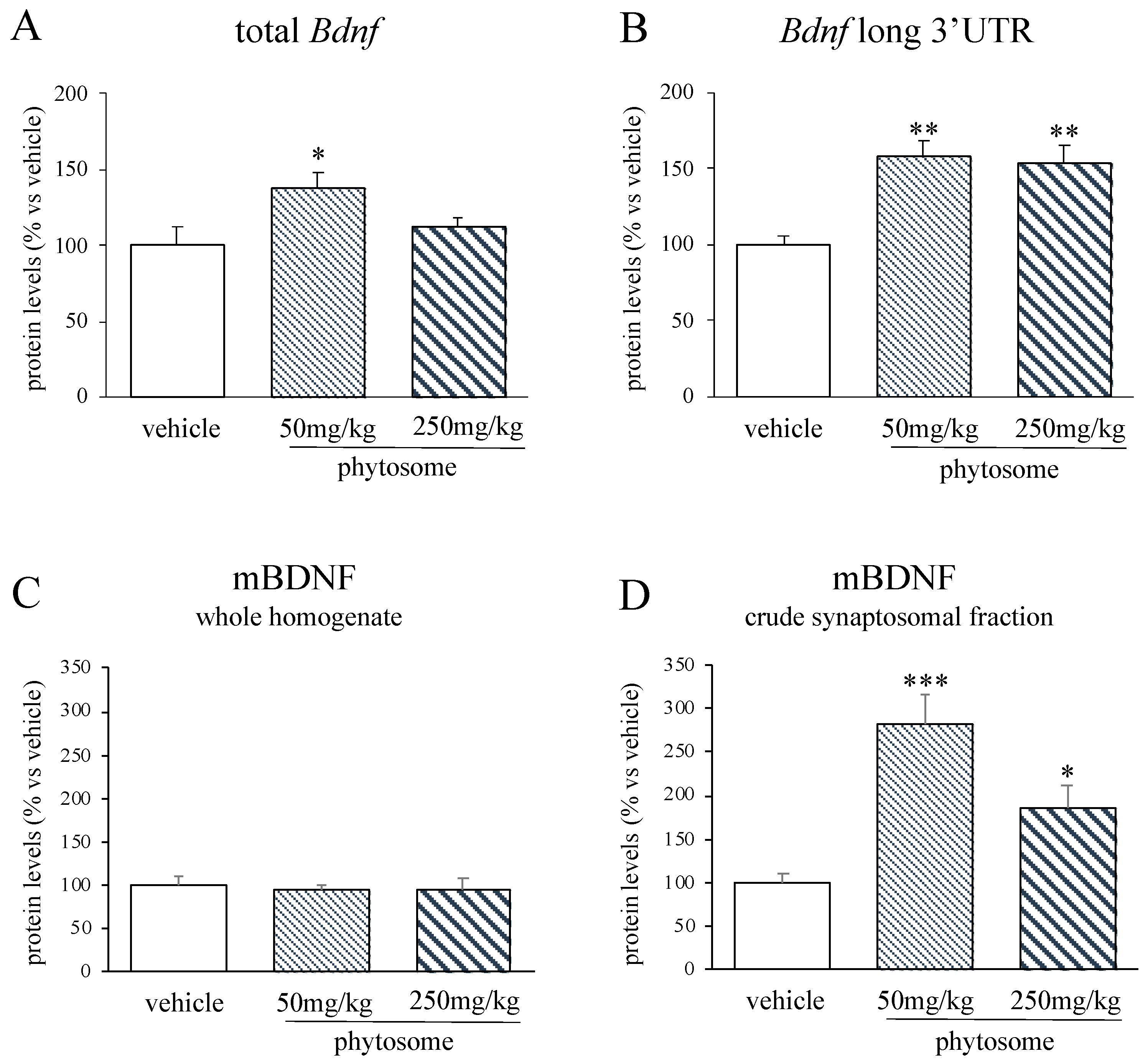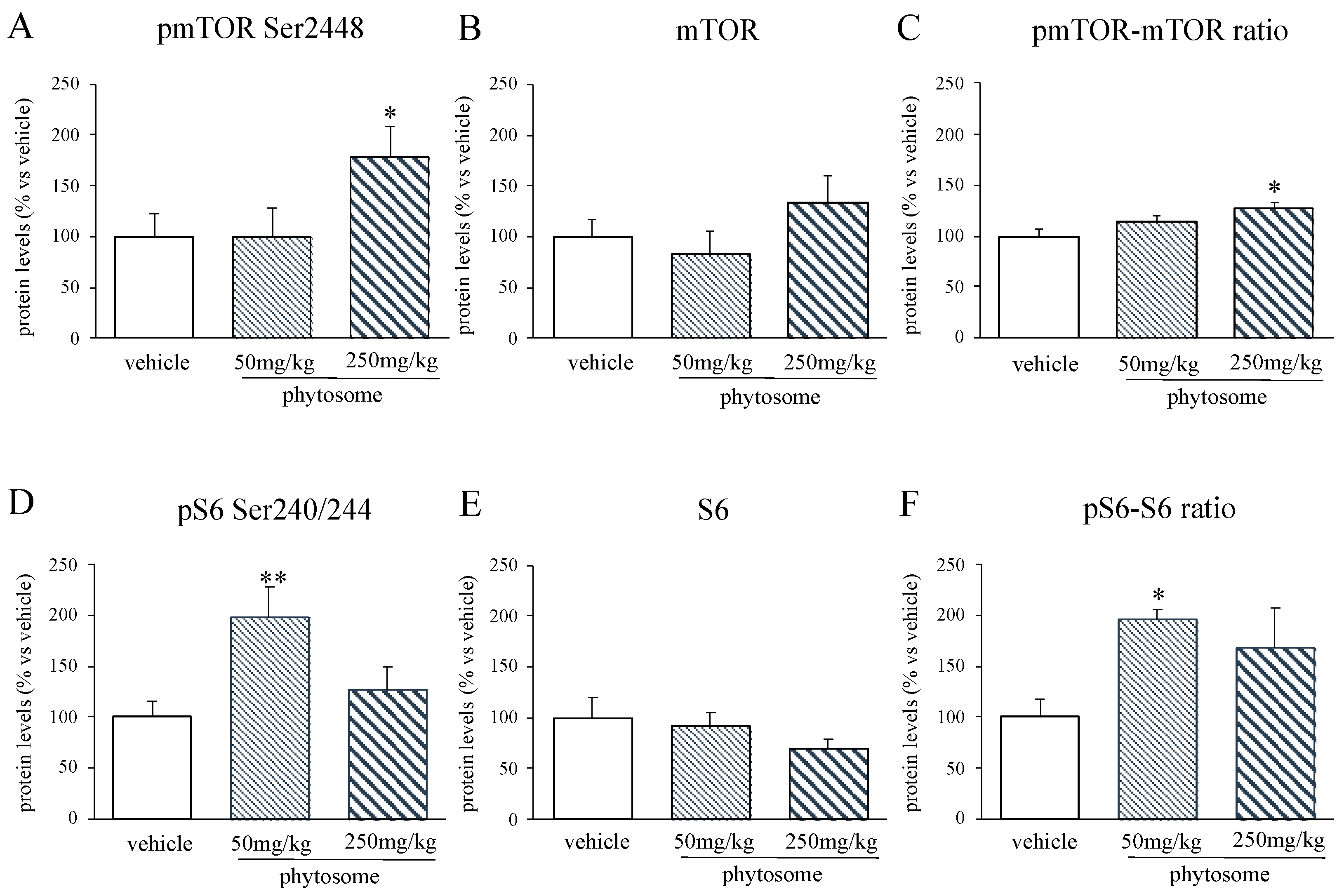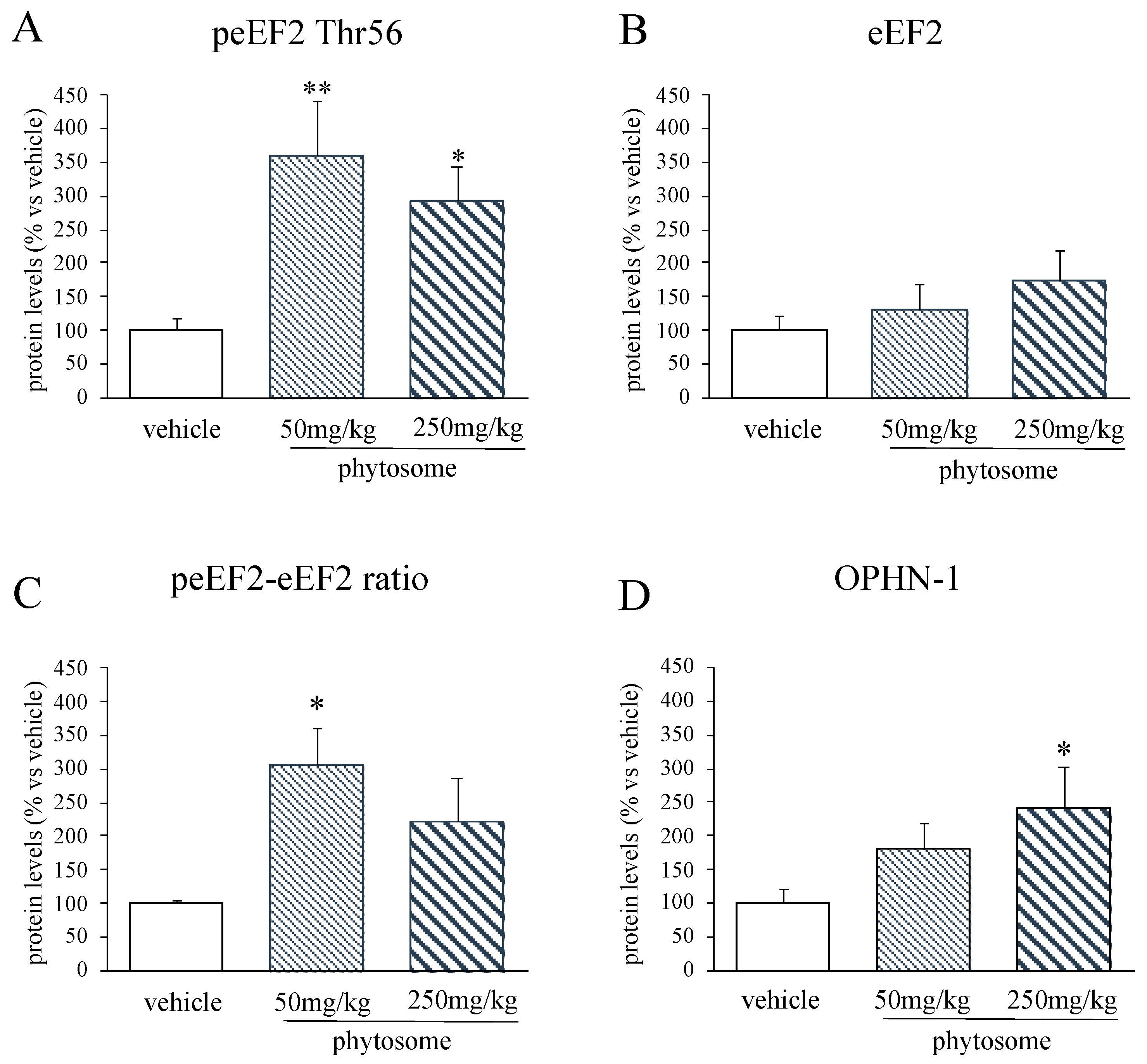Chronic Treatment with a Phytosomal Preparation Containing Centella asiatica L. and Curcuma longa L. Affects Local Protein Synthesis by Modulating the BDNF-mTOR-S6 Pathway
Abstract
1. Introduction
2. Material and Methods
2.1. Plant Material
2.2. Animals
2.3. Treatment
2.4. Quantification of Triterpenes and Curcuminoids in Plasma by LC-MS/MS Analysis
2.5. RNA Preparation and Gene Expression Analysis by Quantitative Real-Time PCR
2.6. Protein Extraction and Western Blot Analysis
2.7. Statistical Analysis
3. Results
3.1. Quantification of Terpenes and Curcuminoids in Plasma by LC-MS/MS Analysis
3.2. Phytosome Administration Increased Bdnf Levels in the PFC
3.3. The Increase of mBDNF Protein Levels Was Paralleled by an Increased Activity of Its Receptor TRKB
3.4. TRKB Phosphorylation in Phytosome-Treated Animals Specifically Activated mTOR-S6 Intracellular Signaling Pathway
3.5. Local Protein Synthesis Is Boosted by Phytosome Administration
4. Discussion
5. Conclusions
Supplementary Materials
Author Contributions
Funding
Acknowledgments
Conflicts of Interest
References
- Lu, B.; Pang, P.T.; Woo, N.H. The yin and yang of neurotrophin action. Nat. Rev. Neurosci. 2005, 6, 603–613. [Google Scholar] [CrossRef] [PubMed]
- Monteggia, L.M.; Tamminga, C.A. Elucidating the role of brain-derived neurotrophic factor in the brain. Am. J. Psychiatry 2007, 164, 1790. [Google Scholar] [CrossRef] [PubMed]
- Yoshii, A.; Constantine-Paton, M. Postsynaptic BDNF-TrkB signaling in synapse maturation, plasticity, and disease. Dev. Neurobiol. 2010, 70, 304–322. [Google Scholar] [CrossRef] [PubMed]
- Manadas, B.; Santos, A.R.; Szabadfi, K.; Gomes, J.R.; Garbis, S.D.; Fountoulakis, M.; Duarte, C.B. BDNF-induced changes in the expression of the translation machinery in hippocampal neurons: Protein levels and dendritic mRNA. J. Proteome Res. 2009, 8, 4536–4552. [Google Scholar] [CrossRef]
- Buffington, S.A.; Huang, W.; Costa-Mattioli, M. Translational Control in Synaptic Plasticity and Cognitive Dysfunction. Annu. Rev. Neurosci. 2014, 37, 17–38. [Google Scholar] [CrossRef]
- Calabrese, F.; Brivio, P.; Gruca, P.; Lason-Tyburkiewicz, M.; Papp, M.; Riva, M.A. Chronic Mild Stress-Induced Alterations of Local Protein Synthesis: A Role for Cognitive Impairment. ACS Chem. Neurosci. 2017, 8, 817–825. [Google Scholar] [CrossRef]
- Sonenberg, N.; Hinnebusch, A.G. Regulation of Translation Initiation in Eukaryotes: Mechanisms and Biological Targets. Cell 2009, 136, 731–745. [Google Scholar] [CrossRef]
- Costa-Mattioli, M.; Gobert, D.; Harding, H.; Herdy, B.; Azzi, M.; Bruno, M.; Bidinosti, M.; Ben Mamou, C.; Marcinkiewicz, E.; Yoshida, M.; et al. Translational control of hippocampal synaptic plasticity and memory by the eIF2α kinase GCN2. Nature 2005, 436, 1166–1173. [Google Scholar] [CrossRef]
- Takei, N.; Kawamura, M.; Hara, K.; Yonezawa, K.; Nawa, H. Brain-derived Neurotrophic Factor Enhances Neuronal Translation by Activating Multiple Initiation Processes. J. Biol. Chem. 2001, 276, 42818–42825. [Google Scholar] [CrossRef]
- Klann, E.; Dever, T.E. Biochemical mechanisms for translational regulation in synaptic plasticity. Nat. Rev. Neurosci. 2004, 5, 931–942. [Google Scholar] [CrossRef]
- Duman, R.S.; Monteggia, L.M. A Neurotrophic Model for Stress-Related Mood Disorders. Biol. Psychiatry 2006, 59, 1116–1127. [Google Scholar] [CrossRef] [PubMed]
- Tanila, H. The role of BDNF in Alzheimer’s disease. Neurobiol. Dis. 2017, 97 Pt B, 114–118. [Google Scholar] [CrossRef]
- Björkholm, C.; Monteggia, L.M. BDNF—A key transducer of antidepressant effects. Neuropharmacology 2016, 102, 72–79. [Google Scholar] [CrossRef] [PubMed]
- Sangiovanni, E.; Brivio, P.; Dell’Agli, M.; Calabrese, F. Botanicals as Modulators of Neuroplasticity: Focus on BDNF. Neural Plast. 2017. [Google Scholar] [CrossRef] [PubMed]
- Sbrini, G.; Brivio, P.; Fumagalli, M.; Giavarini, F.; Caruso, D.; Racagni, G.; Dell’agli, M.; Sangiovanni, E.; Calabrese, F. Centella asiatica l. Phytosome improves cognitive performance by promoting bdnf expression in rat prefrontal cortex. Nutrients 2020, 12, 355. [Google Scholar] [CrossRef] [PubMed]
- Xu, Y.; Ku, B.; Tie, L.; Yao, H.; Jiang, W.; Ma, X.; Li, X. Curcumin reverses the effects of chronic stress on behavior, the HPA axis, BDNF expression and phosphorylation of CREB. Brain Res. 2006, 1122, 56–64. [Google Scholar] [CrossRef] [PubMed]
- Sari, D.C.R.; Arfian, N.; Tranggono, U.; Setyaningsih, W.A.W.; Romi, M.M.; Emoto, N. Centella asiatica (Gotu kola) ethanol extract up-regulates hippocampal brain-derived neurotrophic factor (BDNF), tyrosine kinase B (TrkB) and extracellular signal-regulated protein kinase 1/2 (ERK1/2) signaling in chronic electrical stress model in rats. Iran. J. Basic Med. Sci. 2019, 22, 1218–1224. [Google Scholar] [CrossRef] [PubMed]
- Wang, R.; Li, Y.B.; Li, Y.H.; Xu, Y.; Wu, H.L.; Li, X.J. Curcumin protects against glutamate excitotoxicity in rat cerebral cortical neurons by increasing brain-derived neurotrophic factor level and activating TrkB. Brain Res. 2008. [Google Scholar] [CrossRef]
- Wang, R.; Li, Y.H.; Xu, Y.; Li, Y.B.; Wu, H.L.; Guo, H.; Zhang, J.Z.; Zhang, J.J.; Pan, X.Y.; Li, X.J. Curcumin produces neuroprotective effects via activating brain-derived neurotrophic factor/TrkB-dependent MAPK and PI-3K cascades in rodent cortical neurons. Prog. Neuro-Psychopharmacol. Biol. Psychiatry 2010. [Google Scholar] [CrossRef]
- Paxinos, G.; Watson, C. The Rat Brain in Stereotaxic Coordinates, 6th ed.; Academic Press: Cambridge, MA, USA, 2007. [Google Scholar]
- Brivio, P.; Sbrini, G.; Peeva, P.; Todiras, M.; Bader, M.; Alenina, N.; Calabrese, F. TPH2 deficiency influences neuroplastic mechanisms and alters the response to an acute stress in a sex specific manner. Front. Mol. Neurosci. 2018, 11, 389. [Google Scholar] [CrossRef]
- Brivio, P.; Corsini, G.; Riva, M.A.; Calabrese, F. Chronic vortioxetine treatment improves the responsiveness to an acute stress acting through the ventral hippocampus in a glucocorticoid-dependent way. Pharmacol. Res. 2019. [Google Scholar] [CrossRef] [PubMed]
- Hall, M.N. mTOR-What Does It Do? Transplant. Proc. 2008, 40, S5–S8. [Google Scholar] [CrossRef] [PubMed]
- Wang, X.; Proud, C.G. The mTOR Pathway in the Control of Protein Synthesis. Physiology 2006, 21, 362–369. [Google Scholar] [CrossRef] [PubMed]
- Browne, G.J.; Proud, C.G. A Novel mTOR-Regulated Phosphorylation Site in Elongation Factor 2 Kinase Modulates the Activity of the Kinase and Its Binding to Calmodulin. Mol. Cell. Biol. 2004, 24, 2986–2997. [Google Scholar] [CrossRef] [PubMed]
- Taha, E.; Gildish, I.; Gal-Ben-Ari, S.; Rosenblum, K. The role of eEF2 pathway in learning and synaptic plasticity. Neurobiol. Learn. Mem. 2013, 105, 100–106. [Google Scholar] [CrossRef] [PubMed]
- An, J.J.; Gharami, K.; Liao, G.Y.; Woo, N.H.; Lau, A.G.; Vanevski, F.; Torre, E.R.; Jones, K.R.; Feng, Y.; Lu, B.; et al. Distinct Role of Long 3′ UTR BDNF mRNA in Spine Morphology and Synaptic Plasticity in Hippocampal Neurons. Cell 2008, 134, 175–187. [Google Scholar] [CrossRef] [PubMed]
- Calabrese, F.; Molteni, R.; Maj, P.F.; Cattaneo, A.; Gennarelli, M.; Racagni, G.; Riva, M.A. Chronic duloxetine treatment induces specific changes in the expression of BDNF transcripts and in the subcellular localization of the neurotrophin protein. Neuropsychopharmacology 2007, 32, 2351–2359. [Google Scholar] [CrossRef][Green Version]
- Calabrese, F.; Molteni, R.; Gabriel, C.; Mocaer, E.; Racagni, G.; Riva, M.A. Modulation of neuroplastic molecules in selected brain regions after chronic administration of the novel antidepressant agomelatine. Psychopharmacology 2011, 215, 267–275. [Google Scholar] [CrossRef]
- Calabrese, F.; Luoni, A.; Guidotti, G.; Racagni, G.; Fumagalli, F.; Riva, M.A. Modulation of neuronal plasticity following chronic concomitant administration of the novel antipsychotic lurasidone with the mood stabilizer valproic acid. Psychopharmacology 2013, 226, 101–112. [Google Scholar] [CrossRef]
- Brivio, P.; Sbrini, G.; Corsini, G.; Paladini, M.S.; Racagni, G.; Molteni, R.; Calabrese, F. Chronic Restraint Stress Inhibits the Response to a Second Hit in Adult Male Rats: A Role for BDNF Signaling. Int. J. Mol. Sci. 2020, 21, 6261. [Google Scholar] [CrossRef]
- Rantamäki, T.; Hendolin, P.; Kankaanpää, A.; Mijatovic, J.; Piepponen, P.; Domenici, E.; Chao, M.V.; Männistö, P.T.; Castrén, E. Pharmacologically diverse antidepressants rapidly activate brain-derived neurotrophic factor receptor TrkB and induce phospholipase-Cγ signaling pathways in mouse brain. Neuropsychopharmacology 2007, 32, 2152–2162. [Google Scholar] [CrossRef] [PubMed]
- Moghbelinejad, S.; Nassiri-Asl, M.; Naserpour Farivar, T.; Abbasi, E.; Sheikhi, M.; Taghiloo, M.; Farsad, F.; Samimi, A.; Hajiali, F. Rutin activates the MAPK pathway and BDNF gene expression on beta-amyloid induced neurotoxicity in rats. Toxicol. Lett. 2014, 224, 108–113. [Google Scholar] [CrossRef] [PubMed]
- Szewczyk, B.; Pochwat, B.; Rafało, A.; Palucha-Poniewiera, A.; Domin, H.; Nowak, G. Activation of mTOR dependent signaling pathway is a necessary mechanism of antidepressant-like activity of zinc. Neuropharmacology 2015, 99, 517–526. [Google Scholar] [CrossRef] [PubMed]
- Xiao, D.; Liu, L.; Li, Y.; Ruan, J.; Wang, H. Licorisoflavan A Exerts Antidepressant-Like Effect in Mice: Involvement of BDNF-TrkB Pathway and AMPA Receptors. Neurochem. Res. 2019, 44, 2044–2056. [Google Scholar] [CrossRef]
- Di Prisco, G.V.; Huang, W.; Buffington, S.A.; Hsu, C.C.; Bonnen, P.E.; Placzek, A.N.; Sidrauski, C.; Krnjević, K.; Kaufman, R.J.; Walter, P.; et al. Translational control of mGluR-dependent long-term depression and object-place learning by eIF2α. Nat. Neurosci. 2014, 17, 1073–1082. [Google Scholar] [CrossRef] [PubMed]
- Billuart, P.; Bienvenu, T.; Ronce, N.; des Portes, V.; Vinet, M.C.; Zemni, R.; Crollius, H.R.; Carrié, A.; Fauchereau, F.; Cherry, M.; et al. Oligophrenin-1 encodes a rhoGAP protein involved in X-linked mental retardation. Nature 1998, 392, 923–926. [Google Scholar] [CrossRef]





| (a) Gene | Forward Primer | Reverse Primer | Probe |
| 36b4 | TTCCCACTGGCTGAAAAGGT | CGCAGCCGCAAATGC | AAGGCCTTCCTGGCCGATCCATC |
| Total Bdnf | AAGTCTGCATTACATTCCTCGA | GTTTTCTGAAAGAGGGACAGTTTAT | TGTGGTTTGTTGCCGTTGCCAAG |
| (b) Gene | Accession Number | Assay ID | |
| Bdnf long 3′UTR | EF125675 | Rn02531967_s1 | |
| Protein | Primary Antibody | Secondary Antibody |
|---|---|---|
| mBDNF (14 KDa) | 1:1000 M 3% (Icosagen) 4° O/N | Anti-mouse 1:2000 M 3% 1 h RT |
| pTRKB Y816 (145 KDa) | 1:1000 BSA 5% (Cell Signalling) 4°O/N | Anti-rabbit 1:1000 M 3% 1 h RT |
| TRKB full length (145 KDa) | 1:750 BSA 5% (Cell Signalling) 4° O/N | Anti-rabbit 1:1000 M 3% 1 h RT |
| pmTOR Ser2448 (289 KDa) | 1:1000 BSA 5% (Cell Signalling) 4° O/N | Anti-rabbit 1:5000 M 3% 1 h RT |
| mTOR (289 KDa) | 1:1000 BSA 5% (Cell Signalling) 4° O/N | Anti-rabbit 1:5000 M 3% 1 h RT |
| pS6 Ser240/244 (32 KDa) | 1:1000 BSA 5% (Cell Signalling) 4° O/N | Anti-rabbit 1:2000 M 3% 1 h RT |
| S6 (32 KDa) | 1:1000 BSA 5% (Cell Signalling) 4° O/N | Anti-rabbit 1:1000 M 3% 1 h RT |
| pPLC Tyr783 (155 KDa) | 1:1000 BSA 5% (Cell Signalling) 4° O/N | Anti-rabbit 1:1000 M 5%, 1 h RT |
| PLC (155 KDa) | 1:1000 BSA 5% (Cell Signalling) 4° O/N | Anti-rabbit 1:1000 M 3% 1 h RT |
| pAKT Ser473 (60 KDa) | 1:1000 BSA 5% (Cell Signalling) 4° O/N | Anti-rabbit 1:1000 M 3% 1 h RT |
| AKT (60 KDa) | 1:1000 BSA 5% (Cell Signalling) 4° O/N | Anti-rabbit 1:1000 M 3% 1 h RT |
| pERK1 Thr202 (44 KDa) | 1:1000 BSA 5% (Cell Signalling) 4° O/N | Anti-rabbit 1:2000 M 3% 1 h RT |
| ERK1 (44 KDa) | 1:1000 BSA 5% (Santa Cruz Biotechnology) 4° O/N | Anti-rabbit 1:5000 M 3% 1 h RT |
| pERK2 Tyr204 (44 KDa) | 1:1000 BSA 5% (Cell Signalling) 4° O/N | Anti-rabbit 1:2000 M 3% 1 h RT |
| ERK2 (44 KDa) | 1:1000 BSA 5% (Santa Cruz Biotechnology) 4° O/N | Anti-rabbit 1:5000 M 3% 1 h RT |
| pCREB Ser133 (43 KDa) | 1:1000 BSA 5% (Cell Signalling) 4° O/N | Anti-rabbit 1:5000 M 3% 1 h RT |
| CREB (43 KDa) | 1:1000 BSA 5% (Cell Signalling) 4° O/N | Anti-rabbit 1:5000 M 3% 1 h RT |
| peIF2 Ser51 (38 kDa) | 1:1000 BSA 5% (Cell Signalling) 4° O/N | Anti-rabbit 1:1000 M 3% 1 h RT |
| eIF2 (38 kDa) | 1:1000 BSA 5% (Cell Signalling) 4° O/N | Anti-rabbit 1:1000 M 3% 1 h RT |
| peEF2 Thr56(95 KDa) | 1:1000 BSA 5% (Cell Signalling) 4° O/N | Anti-rabbit 1:1000 M 3% 1 h RT |
| eEF2 (95 KDa) | 1:1000 BSA 5% (Cell Signalling) 4° O/N | Anti-rabbit 1:1000 M 3% 1 h RT |
| OPHN-1 (91 KDa) | 1:1000 BSA 5% (Santa Cruz) 4° O/N | Anti-mouse 1:1000 M 3% 1 h RT |
| β-ACTIN (43 KDa) | 1:10,000 M 3% (Sigma-Aldrich) 45 min RT | Anti-mouse 1:10,000 M 3% 45 min RT |
| Protein | Vehicle | Phytosome 50 mg/kg | Phytosome 250 mg/kg |
|---|---|---|---|
| pPLC Tyr783 | 100 ± 10 | 76 ± 7 | 104 ± 17 |
| PLC | 100 ± 13 | 97 ± 9 | 114 ± 15 |
| pPLC–PLC ratio | 100 ± 5 | 94 ± 7 | 92 ± 10 |
| pAKT Ser473 | 100 ± 13 | 200 ± 35 * | 203 ± 34 * |
| AKT | 100 ± 28 | 115 ± 20 | 85 ± 5 |
| pAKT–AKT ratio | 100 ± 16 | 165 ± 64 | 204 ± 31 * |
| pERK1 Thr202 | 100 ± 21 | 96 ± 15 | 106 ± 24 |
| ERK1 | 100 ± 15 | 101 ± 13 | 81 ± 11 |
| pERK1–ERK1 ratio | 100 ± 8 | 127 ± 22 | 131 ± 29 |
| pERK2 Tyr204 | 100 ± 20 | 142 ± 21 | 202 ± 37 * |
| ERK2 | 100 ± 13 | 97 ± 7 | 80 ± 9 |
| pERK2–ERK2 ratio | 100 ± 46 | 110 ± 18 | 187 ± 49 |
| pCREB Ser133 | 100 ± 18 | 115 ± 27 | 87 ± 15 |
| CREB | 100 ± 14 | 107 ± 19 | 114 ± 38 |
| pCREB–CREB ratio | 100 ± 10 | 131 ± 24 | 118 ± 21 |
| peIF2 Ser51 | 100 ± 11 | 123 ± 23 | 118 ± 15 |
| eIF2 | 100 ± 6 | 116 ± 15 | 111 ± 10 |
| peIF2–eIF2 ratio | 100 ± 10 | 104 ± 11 | 105 ± 9 |
Publisher’s Note: MDPI stays neutral with regard to jurisdictional claims in published maps and institutional affiliations. |
© 2020 by the authors. Licensee MDPI, Basel, Switzerland. This article is an open access article distributed under the terms and conditions of the Creative Commons Attribution (CC BY) license (http://creativecommons.org/licenses/by/4.0/).
Share and Cite
Sbrini, G.; Brivio, P.; Sangiovanni, E.; Fumagalli, M.; Racagni, G.; Dell’Agli, M.; Calabrese, F. Chronic Treatment with a Phytosomal Preparation Containing Centella asiatica L. and Curcuma longa L. Affects Local Protein Synthesis by Modulating the BDNF-mTOR-S6 Pathway. Biomedicines 2020, 8, 544. https://doi.org/10.3390/biomedicines8120544
Sbrini G, Brivio P, Sangiovanni E, Fumagalli M, Racagni G, Dell’Agli M, Calabrese F. Chronic Treatment with a Phytosomal Preparation Containing Centella asiatica L. and Curcuma longa L. Affects Local Protein Synthesis by Modulating the BDNF-mTOR-S6 Pathway. Biomedicines. 2020; 8(12):544. https://doi.org/10.3390/biomedicines8120544
Chicago/Turabian StyleSbrini, Giulia, Paola Brivio, Enrico Sangiovanni, Marco Fumagalli, Giorgio Racagni, Mario Dell’Agli, and Francesca Calabrese. 2020. "Chronic Treatment with a Phytosomal Preparation Containing Centella asiatica L. and Curcuma longa L. Affects Local Protein Synthesis by Modulating the BDNF-mTOR-S6 Pathway" Biomedicines 8, no. 12: 544. https://doi.org/10.3390/biomedicines8120544
APA StyleSbrini, G., Brivio, P., Sangiovanni, E., Fumagalli, M., Racagni, G., Dell’Agli, M., & Calabrese, F. (2020). Chronic Treatment with a Phytosomal Preparation Containing Centella asiatica L. and Curcuma longa L. Affects Local Protein Synthesis by Modulating the BDNF-mTOR-S6 Pathway. Biomedicines, 8(12), 544. https://doi.org/10.3390/biomedicines8120544







